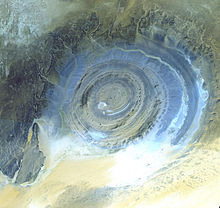- Dome (geology)
-
In structural geology, a dome is a deformational feature consisting of symmetrically-dipping anticlines; their general outline on a geologic map is circular or oval. The strata in a dome are upwarped in the center; if the top of a dome is eroded off, the result will be a series of concentric strata that grow progressively older from the outside-in, with the oldest rocks exposed at the center. Many geologic domes are too large to be appreciated from the surface, and are apparent only in maps. Well-known regional structural domes include the Llano Uplift and the Ozark Dome.[1]
Domes formed by intrusives
Localized domes may be formed when magma forms a shallow intrusion warping the overlying strata. An example would be the laccolith domes of the Henry Mountains of southeastern Utah. Salt domes are formed above a diapiric intrusion of low density evaporite rocks.
See also
References
- ^ Monroe, James S., and Reed Wicander. The Changing Earth: Exploring Geology and Evolution. 2nd ed. Belmont: Wadsworth Publishing Company, 1997. ISBN 0-314-09577-2

This tectonics article is a stub. You can help Wikipedia by expanding it.

